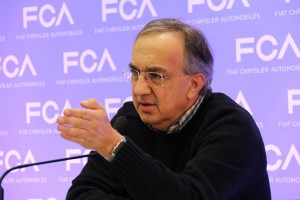
FCA CEO Sergio Marchionne touted the company's improved margins. He also suggested the company may add more autonomous tech suppliers.
Fiat Chrysler Automobiles N.V. delivered better-than-expected financials results for the first quarter of the year, including an 11% jump in adjusted earnings to 1.54 billion euros, slightly higher than the predicted 1.4 billion euros.
The company beat expectations despite a slow start to the year in North America where FCA has pulled back on sales to rental fleets and started remodeling manufacturing plants to build more trucks and sport utility vehicles.
Sergio Marchionne, FCA chief executive, noted the entire company’s margins were up 30 basis points to 5.5% and despite the ongoing changes in North America, the NAFTA region climbed to 7.3% thanks to strong sales of Jeeps and sport-utility vehicles.
Perhaps the most pleasant surprise was the performance of Maserati, which saw its margin improve to 11.3% from 3.1, Marchionne said. Overall, the increase was driven by continued strong operating performance that also reflection a drop in financial expenses as result of gross debt reduction, he added.
(SUVs could soon make up half of U.S. new vehicle market. Click Here for the story.)
FCA has been retooling some U.S. factories to boost output of sport-utility vehicles and trucks and discontinue production of some unprofitable sedans in a bid to strengthen its finances at a time the U.S. car market is coming off its peak.
“(North America) and net debt were the main area of focus and came out better than expected, which should reassure investors regarding the ability of FCA to maintain a 7% plus level of operating margin in North America despite a tougher environment,” Barclays said in a note.
Shipments in North America dropped during the period as FCA phased out its low-margin small cars Dodge Dart and Chrysler 200 in favor of its new higher-margin Jeep Compass.
Overall, net debt stood at 5.1 billion euros at the end of March, half a billion euros higher than three months earlier, which the company attributed to seasonal factors. It did, however, use some of its available cash to pay off gross debt.
Profitability improved in Europe too during the first quarter, helped by strong sales of Alfa Romeo’s Giulia and Stelvio models, while margins at luxury brand Maserati nearly quadrupled on the back of strong demand for its first SUV, Levante.
(Alfa Romeo reveals more versions of luxurious Stelvio SUV at NY Auto Show. Click Here to check them out.)
Cash flows from operations, net of capital expenditures, improved 400 million euros from the first quarter of 2016, while FCA’s available liquidity remained strong
For the full-year FCA said net revenues should reach between 115 billion euros and 120 billion euros while adjusted earnings before earnings, interest and taxes or EBIT should 7.0 billion euros.
FCA also may seek more supplier partners to help it develop and build self-driving vehicles, Marchionne said.
The Jeep and Ram brands are strong enough to exist as standalone entities outside FCA, Marchionne also said on a conference call with analysts after the company reported record first-quarter results. But he did not elaborate on whether there were any plans for a spin-off of either, like with Ferrari.
FCA currently has a partnership with Alphabet’s Waymo self-driving unit. Marchionne said Waymo has an “unbeatable solution” to help build self-driving vehicles, including versions of the Chrysler Pacifica hybrid minivan, but that FCA is looking at additional partners.
“Between now and the next three years, we need to provide viable solutions to take people around,” Marchionne said, citing Waymo’s new test program in Phoenix offering ride sharing in self-driving Pacificas.
(Click Here to check out the 707 hp Jeep Grand Cherokee Trackhawk.)
But FCA is considering more partners “because banking all of our solutions on one possible outcome is going to be disastrous,” Marchionne said.
